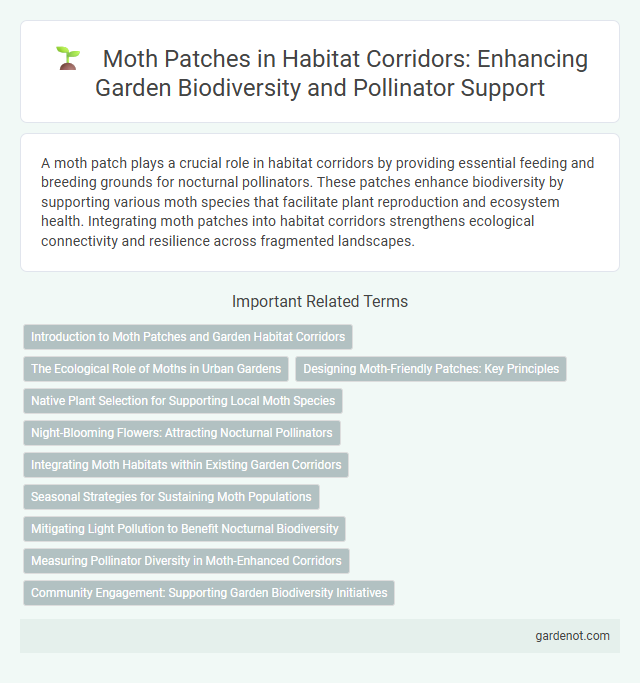A moth patch plays a crucial role in habitat corridors by providing essential feeding and breeding grounds for nocturnal pollinators. These patches enhance biodiversity by supporting various moth species that facilitate plant reproduction and ecosystem health. Integrating moth patches into habitat corridors strengthens ecological connectivity and resilience across fragmented landscapes.
Introduction to Moth Patches and Garden Habitat Corridors
Moth patches serve as vital microhabitats within garden habitat corridors, providing essential resources such as nectar, shelter, and breeding sites for diverse moth species. These patches contribute to ecological connectivity by supporting pollination and serving as prey for other wildlife, enhancing overall biodiversity. Strategically placed moth patches in garden habitat corridors optimize habitat continuity, facilitating species movement and genetic exchange across fragmented landscapes.
The Ecological Role of Moths in Urban Gardens
Moth patches in urban gardens serve as critical habitat corridors that support nocturnal pollinators essential for maintaining biodiversity and plant reproduction. These patches enhance ecological connectivity by providing food resources and shelter, enabling moth populations to thrive despite urban fragmentation. Preserving moth habitats in city gardens boosts ecosystem resilience and promotes the health of native flora.
Designing Moth-Friendly Patches: Key Principles
Designing moth-friendly patches requires prioritizing native plant species that provide nectar and larval food sources, ensuring continuous bloom periods to support moth populations throughout their life cycle. Incorporating structural diversity with varied vegetation heights and densities creates ideal microhabitats for resting and protection from predators. Minimizing artificial light pollution enhances nocturnal moth activity and promotes successful breeding within habitat corridors.
Native Plant Selection for Supporting Local Moth Species
Native plant selection in moth patches is crucial for supporting local moth species by providing essential nectar sources and larval host plants that sustain their life cycles. Incorporating a diverse array of native wildflowers, grasses, and shrubs creates a habitat that meets the dietary and shelter needs of various moth species, promoting biodiversity and ecological balance. Strategic planting of species such as goldenrod, milkweed, and wild violets enhances moth patch effectiveness by attracting and nurturing native moth populations.
Night-Blooming Flowers: Attracting Nocturnal Pollinators
Night-blooming flowers in moth patches play a crucial role in supporting nocturnal pollinators such as moths and bats, which are essential for maintaining biodiversity within habitat corridors. These flowers emit strong fragrances and exhibit pale or white colors that enhance visibility in low-light conditions, optimizing pollinator attraction and facilitating effective pollination. Preserving and restoring these specialized floral communities strengthens ecosystem connectivity and promotes the survival of nocturnal species critical to healthy habitats.
Integrating Moth Habitats within Existing Garden Corridors
Moth patches can be seamlessly integrated into existing garden corridors by planting native flowering species that provide essential nectar sources and host plants for moth larvae. Creating diverse vegetation layers within these corridors enhances shelter and breeding sites, promoting moth biodiversity and population stability. Utilizing night-blooming plants further supports nocturnal pollinators, enriching the overall ecological function of the habitat corridor.
Seasonal Strategies for Sustaining Moth Populations
Moth patches play a crucial role in habitat corridors by offering seasonal resources that sustain moth populations, including nectar sources in spring and summer and suitable overwintering sites in fall. Effective management of these patches ensures the availability of host plants for larval development and microhabitats that protect moths from extreme weather. Integrating diverse native vegetation and preserving undisturbed leaf litter enhances population resilience through seasonal cycles.
Mitigating Light Pollution to Benefit Nocturnal Biodiversity
Moth patches within habitat corridors play a crucial role in mitigating light pollution by creating dark refuges that support nocturnal biodiversity. These patches reduce artificial light intrusion, enabling moths and other night-active species to navigate, feed, and reproduce effectively. Conservation efforts targeting light pollution reduction in moth patches enhance ecosystem health and preserve vital nocturnal pollination networks.
Measuring Pollinator Diversity in Moth-Enhanced Corridors
Measuring pollinator diversity in moth-enhanced corridors involves tracking species richness and abundance using nocturnal light traps and DNA metabarcoding techniques. Habitat corridors with abundant moth patches demonstrate increased pollinator activity, enhancing ecosystem connectivity and promoting gene flow among plant populations. These corridors play a critical role in sustaining nocturnal pollinator networks essential for biodiversity conservation.
Community Engagement: Supporting Garden Biodiversity Initiatives
Moth Patch fosters community engagement by supporting garden biodiversity initiatives that enhance local ecosystems and promote native pollinators. Through collaborative workshops and citizen science projects, residents contribute to creating interconnected habitat corridors that sustain moth populations and other vital species. These efforts strengthen urban green spaces, improving ecological resilience and biodiversity.
Moth patch, Infographic

 gardenot.com
gardenot.com